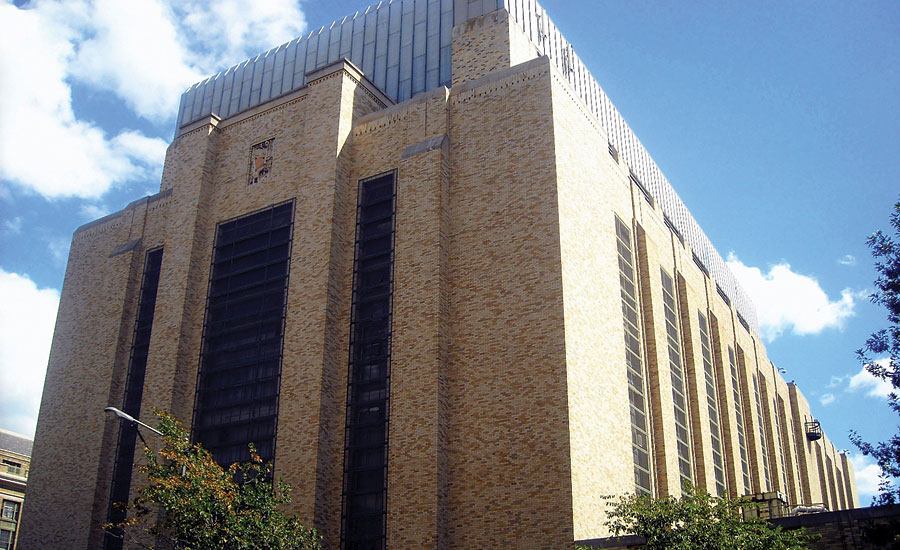Birdsill Holly (isn’t that a delightful name?) was born in 1820 in Upstate New York. He liked to invent things. In 1851, he was living in Lockport, N.Y., which is very near Niagara Falls. He built a large steam boiler and then ran pipe under the streets of Lockport to deliver steam heat, which was brand-new at the time, to his neighbors. And that’s how district heating was born.
Some folks from Denver showed up in 1880 to take a peek at what Birdsill had built. They returned to Colorado and constructed a much larger district steam system in their city, which was only 22 years old. It continues to serve downtown Denver today. Nice.
New York City, not to be outdone by that young, Western upstart of a city, followed two years later and that steam system continues to roar, providing steam to the Empire State Building, Rockefeller Center and other iconic buildings. It is the largest district steam system in the world.
And Holly did something else that was pretty significant in American history. He thought about the buried steam pipe and how he could do a similar thing with buried water pipe. And no, I’m not talking about heating buildings with hot water. I’m talking about putting out fires.
Yep, Birdsill also invented the fire hydrant.
That was in 1863. He thought it was such a fine idea, one that could really make big cities safer. Holley took a train to Chicago and tried to convince the politicians they really needed his newfangled method of fighting fires, but they weren’t buying it, so he got back on the train and went home.
Eight years later, the Great Chicago Fire destroyed 3.3 square miles and left more than 100,000 people homeless. (It’s said that Mrs. O’Leary’s cow kicked over the lantern that started the fire, but it’s just a myth.)
So there.
On July 8, 2007, water hammer hit an elbow in a steam main buried under the intersection of New York City’s Lexington Ave. and 41st St. in midtown Manhattan. The resulting explosion put debris on top of the Chrysler Building.
It turns out two clogged steam traps got together with a heavy rainfall that flowed down a manhole that morning and soaked the outside of the steam main. The cold water on the outside of the pipe caused the steam on the inside of the pipe to quickly condense, and since those two steam traps were clogged, the big slug of condensate pretended it was a cannon ball. It traveled a few blocks and destroyed that big, buried elbow, blowing up the whole intersection. It cost Consolidated Edison $37 million to make it right.
And that’s a very good reason to keep an eye on district heating, especially if it’s a high-pressure steam system. Maintenance matters.
Renewables on the rise
A few winters ago, it looked like the price of fuel oil was going to just keep going up. Fracking had lowered the price of natural gas, and many Americans in the Northeast, where fuel oil has long been popular, were switching to gas.
The city fathers in the capital city of Montpelier, Vt., were losing their shirts on fuel oil, so they looked for a solution. Rather than switch to natural gas in all their boilers, they decided a biomass-fired, district hot water system was the best choice for their downtown. After all, this was Vermont, a state not lacking in trees.
I followed this whole process as it played out in the news for a few years. It took a while to get all the legal stuff in order. Then they began running the pipe under the city streets and contracting for the construction of the new biomass boiler plant. Excitement built, and more and more Vermonters paid attention to this new system and the savings it promised. Imagine heating the whole downtown with what’s laying on the ground right over there in the woods.
On the day they lit off the new system, all the politicians showed up to have photos taken. They made speeches and cut the ribbon and everyone cheered.
And then the price of fuel oil plummeted, making the brand-new biomass plant way more expensive to operate than anyone had thought.
Go figure.
But keep an eye on district heating because it’s getting bigger all over the world, and it brings with it great news for hydronics.
In a suburb of Paris, they’re digging down about 2,500 ft. to get to water that’s a constant 83° F. They’ll use this, summer and winter, as their geothermal source to heat and provide hot water for 1,500 new homes. They’ll also be heating all the shops in town, as well as the neighborhood swimming pool. The used water will be pumped back into the ground, where it can return to its original temperature and serve yet again. And they’re doing it with pumps, heat exchangers and other hydronic goodies.
On a smaller scale, and in downtown Paris, they’re capturing the body heat of the people passing through the Metro stop by the Pompidou Museum, as well as the heat from the trains passing by underground. They’re using an air-to-water heat exchanger to capture the heat, which then flows to the radiators in 17 social-housing apartments next to the Metro stop.
The Swedes have been doing a similar thing within Stockholm’s main train station since 2010. They capture the body heat of the 250,000 people who pass through each day, and use that heat (again, though an air-to-water heat exchanger) to warm an office building down the block.
And none of this is really new. The hot bodies alone at the Mall of America in Bloomington, Minn., have been heating that place since 1992. Who needs a heating system when all those people are moving around and giving up Btu?
And I know, that’s not exactly district heating, but it does make me smile.
North Carolina is home to a 1 million-sq.-ft. business park that runs on a district hot water system. The heat comes from 640 solar thermal collectors that grab Btu every day. During the summer, they store the heat in boreholes and bring it back up when it gets chilly. The Earth is a terrific heat sink.
Another builder is doing the same thing in a 52-house subdivision in Alberta, Canada. Solar panels, boreholes and lots of hydronics. See the future.
In the United Kingdom right now, about 210,000 houses are connected to hot water district heating systems. The government believes that by 2030, 8 million Britons will be using district heating.
The Paris agreement on climate change also plays into this. The UK has vowed to do away with all gas-fired boilers and gas cooking stoves. That changes everything, and I suspect once they get over the initial alarm, homeowners will warm to the idea of district heating because instead of having to buy and maintain a boiler, they’ll have these relatively simple metal boxes containing a heat exchanger, circulator, a bit of pipe, valves, fittings, gauges and a Btu meter. You know, hydronic stuff.
And the other attraction over there right now is the district heating market, unlike their electricity market, is unregulated. The government is letting the heating providers set the price, which makes it very attractive to investors who are thinking long-term.
Copenhagen’s district heating system is one of the world’s largest hot-water systems. This one burns garbage to produce electricity, and uses the waste heat to provide heat and hot water to 98% of the buildings in that beautiful Danish city.
And you would think the building that houses the incinerator would be ugly, right? It’s not. This place is absolutely whimsical. They built it so people can ski on artificial snow from its top, around the whole building, and down onto the street. It also has a special smokestack that blows steam rings into the sky whenever they save a certain amount of carbon. Danes are fun people.
To me, the most interesting thing about district heating is the way it’s branching out and moving away from coal, oil and natural gas. I’m seeing more and more of these systems running on biomass, garbage, body heat, sunlight, the constant temperature of large bodies of water, the water in flooded mines or, in the case of Iceland, the lava that’s not far underground. It’s all fascinating, and it’s all about hydronics on a very large scale. It’s worth keeping an eye on.
And I think Birdsill Holly would approve.
This article was originally titled “Eye of district heating in the August 2016 print edition of PM Engineer.




